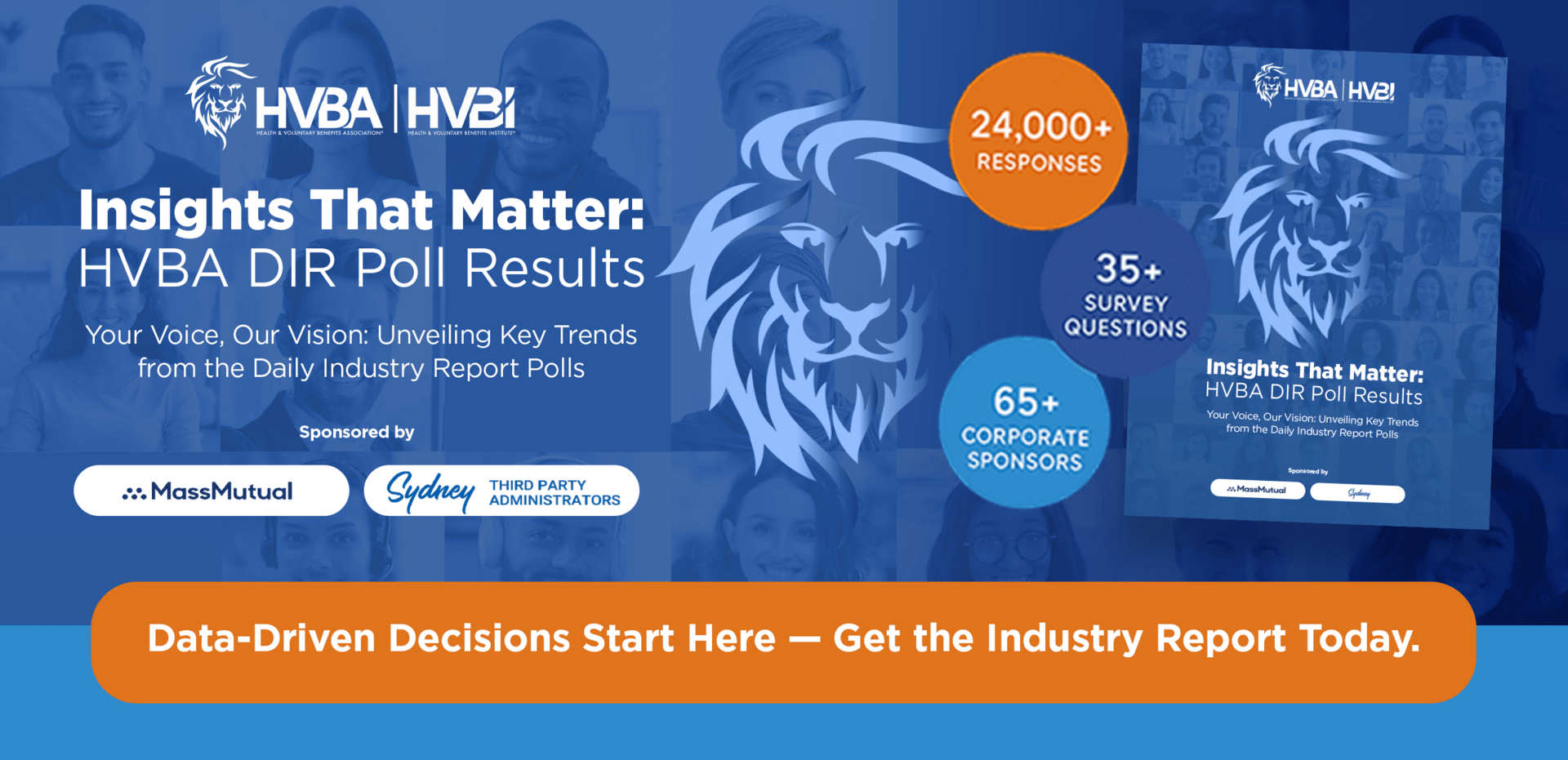- Daily Industry Report
- Posts
- Daily Industry Report - July 24
Daily Industry Report - July 24

Your summary of the Voluntary and Healthcare Industry’s most relevant and breaking news; brought to you by the Health & Voluntary Benefits Association®
Jake Velie, CPT | Robert S. Shestack, CCSS, CVBS, CFF |
The Myth of All-American Drugs and What Trump’s Tariffs Miss About Pharma Supply Chains
By Frank Vinluan - Pharmaceutical tariffs are coming, part of President Trump’s stated goal of bringing drug manufacturing back to the U.S. Untangling the sprawling, global supply chain will be complicated and expensive, and could inadvertently compete with other administration goals regarding drug pricing and availability. Read Full Article…
HVBA Article Summary
Global Supply Chain Dependence Complicates Tariff Policy: The pharmaceutical industry, including smaller clinical-stage companies like Nkarta, relies heavily on an international network for raw materials, active pharmaceutical ingredients (APIs), excipients, and specialized equipment. Even when drugs are finished or packaged in the U.S., key components often come from suppliers overseas. This global interdependence means new pharmaceutical tariffs could significantly raise costs and disrupt production, as relocating these supply chains to the U.S. would be complex, time-consuming, and expensive.
Tariffs Could Raise Drug Costs and Exacerbate Shortages: Tariffs are likely to drive up expenses for drugmakers, especially for generic medicines with already thin profit margins and for biologics that require specialized, often scarce, manufacturing inputs. These added costs could translate into higher drug prices for patients, further strain already fragile generic supply chains, and lead some companies to stop producing certain low-margin medicines altogether. Such pressures risk worsening existing drug shortages while conflicting with policy goals of lowering costs and improving availability.
Policy Implementation Faces Structural and Timing Barriers: Building new drug manufacturing capacity in the U.S. is a multi-year process that involves not only constructing facilities but also securing FDA approvals for both plants and products. Existing trade agreements like the WTO’s long-standing pharma pact further complicate tariff enforcement and timing, as bypassing or renegotiating these agreements could create legal and economic hurdles. As a result, even with announced plans for new U.S.-based production, pharmaceutical tariffs are unlikely to deliver immediate reshoring or cost benefits, and could instead create short-term disruption.
HVBA Poll Question - Please share your insightsShould A&H carriers provide a 1099 for Accident, Critical Illness, and Hospital Indemnity claims exceeding $600? |
Our last poll results are in!
59.38%
Of Daily Industry Report readers who participated in our last polling question, when asked, “What strategies do you feel are most effective to gain deeper transparency into — and thereby better manage — total pharmacy spend?” responded with “disaggregate PBM management & functions (formularies, clinical, claims, network access & rebates).”
25% feel the most effective strategies are to “leverage robust data & reporting tools that allow you to analyze costs and trends,” while 9.37% believe it to be “partnering with a smaller, more flexible PBM that will allow formulary customization.” The remaining 6.25% feel that “carve-out specialty vs. traditional drugs, especially the biosimilar drugs,” are the most effective strategies to gain deeper transparency into — and therefore better manage — total pharmacy spend.
Have a poll question you’d like to suggest? Let us know!
AI is already touching nearly every corner of the medical field
By Sage Lazzaro - When ChatGPT entered the conversation a few years ago, Lloyd B. Minor, a surgeon and the dean of the Stanford School of Medicine, sought to test its ability by asking it about a rare inner ear condition called superior canal dehiscence syndrome. Minor had personally discovered the syndrome, wrote the first paper on it, and developed a surgical procedure to fix it, naturally making him an expert on the subject. The response, he says, was not only concise, accurate, and logical, but as good as anything he could have written. Read Full Article…
HVBA Article Summary
AI Is Reshaping Medical Research and Drug Discovery: Artificial intelligence, particularly models like AlphaFold2 and AlphaGenome, is accelerating breakthroughs in areas such as protein structure prediction, drug design, disease detection, and genetic research. These advancements are streamlining early drug development, supporting diagnostic accuracy, and sparking growth in biotech innovation, though AI-developed drugs still face traditional testing and regulatory hurdles before reaching patients.
AI Streamlines Physician Workflows and Enhances Patient Care: Large language models are helping reduce administrative burdens by summarizing medical records, transcribing patient-provider interactions, and simplifying access to medical data. These tools give doctors more time for patient interaction and help improve care through applications like chronic condition monitoring, AI-assisted radiology, and diagnostic support, though risks like errors and bias remain concerns.
Medical Training and Practice Are Evolving Alongside AI: Medical schools are integrating AI into curricula through specialized courses, tools like ChatGPT, and AI-driven training simulators, preparing future physicians to leverage these technologies while retaining core medical expertise. This shift reflects a broader transformation of how doctors learn, practice, and keep up with rapidly advancing knowledge, even as healthcare systems cautiously manage the risks of AI adoption.
Direct Primary Care Providers Get a Major Policy Win
By Randy Dotinga - Clinicians who provide “direct primary care” (DPC) and their patients are gaining a major windfall from the recently passed federal budget reconciliation legislation. Thanks to the “Big Beautiful Budget Bill,” patients will be able to dip into their health savings accounts (HSAs) to pay for DPC services, which are designed to offer relief from assembly-line medicine. Read Full Article…
HVBA Article Summary
Direct Primary Care Expands as HSA Rules Change: Beginning January 1, individuals with high-deductible health plans will be allowed to use Health Savings Account funds to pay for Direct Primary Care (DPC) membership fees, with limits of $150 per month for individuals and $300 per family. This policy shift, backed by bipartisan support, is projected to cost the federal government about $2.8 billion through 2034 but is expected to make DPC more financially accessible for those already enrolled in high-deductible plans.
DPC Offers Personalized Care but Limited Coverage: DPC enables patients to pay a fixed monthly fee directly to physicians for unlimited routine primary care, preventive services, basic procedures, and shorter wait times, while eliminating copays and many administrative burdens. However, the model generally excludes prescription drugs, specialty care, and more complex services, making it appealing to many providers and patients seeking streamlined, personalized care but less comprehensive for those with extensive medical needs.
Equity Concerns Persist as DPC Grows: While proponents see DPC as a way to improve patient autonomy and physician satisfaction by reducing bureaucracy and allowing smaller patient panels, critics argue it risks worsening healthcare inequities. They warn that the model draws physicians away from traditional primary care, favors healthier, wealthier patients who can afford monthly fees or HSA contributions, and leaves lower-income individuals with fewer providers and reduced access to care.
By Emily Olsen - Insurers submit rate filings to state regulators each spring and summer to justify their premium changes for the following plan year. Typically, medical costs are the biggest factor behind premium changes — but planning for 2026 also reflects significant policy changes on the horizon, according to KFF and Peterson. Read Full Article…
HVBA Article Summary
Insurers are requesting significant premium increases for 2026: Most payers across 19 states and Washington, D.C., are seeking hikes of 10–20%, with more than one-quarter proposing increases exceeding 20%. This marks a sharp departure from recent years, as 2025 premiums rose only about 4%, from $477 to $497 on average, highlighting a steep acceleration in projected rate growth.
Policy and economic uncertainties are driving rate pressures: Insurers are attributing their larger proposed increases to factors such as the potential expiration of enhanced premium tax credits at the end of 2025, uncertainty over tariff policies that could raise the cost of drugs and medical equipment, and broader inflationary pressures. Some insurers estimate tariffs alone could be adding about 3% to premiums compared with typical rate-setting.
Upcoming federal policies could further impact premiums and coverage: A recently signed tax law, CMS regulations shrinking ACA enrollment windows and tightening eligibility checks, and the possible end of subsidies could collectively reduce enrollment and increase the share of sicker, costlier enrollees in the marketplaces. Analysts warn these changes could accelerate premium hikes and lead to higher uninsured rates, with finalized 2026 rates expected later in the summer.
It's time to remind employees to use their FSA
By Lee Hafner - Flexible spending accounts (FSAs) are a wonderful way for employees to purchase health-related products and services, but millions of dollars end up leftover in these accounts — money they then forfeit — at the end of the year. With enhanced communication, benefit leaders can educate and encourage employees to use their FSA funds wisely from now through year's end, ensuring they maximize their offering. Read Full Article… (Subscription required)
HVBA Article Summary
Seasonal and event-based reminders can boost FSA engagement: Encouraging employees to use their FSA dollars for common items like sunscreen, first aid kits, and allergy medicine, as well as for seasonal needs tied to events such as back-to-school shopping, fall sports, and cold-and-flu season, helps them recognize how these funds can cover expenses they’re already planning for, ultimately increasing benefit utilization.
Clear communication is critical for employee awareness: Sharing reminders through emails, posters in shared spaces, and discussions during open enrollment sessions ensures employees know not only which everyday health and wellness products are FSA-eligible, including newer items like wearable health trackers and skincare devices, but also how to access their account balances and take advantage of evolving product categories.
Understanding plan rules enhances financial benefits: Educating employees about key plan details, including year-end deadlines, grace periods, run-out periods for submitting claims, and rollover allowances, helps them avoid forfeiting unused funds and empowers them to plan purchases strategically, maximizing the financial value of their FSA dollars.
This Open Enrollment, Will Enterprises Finally Embrace the Individual Market?
By Jack Hooper - In just a few months, open enrollment will begin for health insurance plans on the Affordable Care Act (ACA) marketplace. We tend to think about individual buyers when we think about the marketplace’s open enrollment — those who don’t get their health insurance through a group plan from their employer. Read Full Article…
HVBA Article Summary
Seasonal and event-based reminders can boost FSA engagement: Encouraging employees to use their FSA dollars for common items like sunscreen, first aid kits, and allergy medicine, as well as for seasonal needs tied to events such as back-to-school shopping, fall sports, and cold-and-flu season, helps them recognize how these funds can cover expenses they’re already planning for, ultimately increasing benefit utilization.
Clear communication is critical for employee awareness: Sharing reminders through emails, posters in shared spaces, and discussions during open enrollment sessions ensures employees know not only which everyday health and wellness products are FSA-eligible, including newer items like wearable health trackers and skincare devices, but also how to access their account balances and take advantage of evolving product categories.
Understanding plan rules enhances financial benefits: Educating employees about key plan details, including year-end deadlines, grace periods, run-out periods for submitting claims, and rollover allowances, helps them avoid forfeiting unused funds and empowers them to plan purchases strategically, maximizing the financial value of their FSA dollars.

Delta Dental, other insurer groups defend provider network leasing rules
By Allison Bell - Groups for dentists and groups for dental plans are clashing over the future of dental services provider network leasing rules. The outcome could affect whether dental plans must persuade the dentists in their provide networks to opt in when the plans are leasing use of the networks to outside organizations, such as dental insurers, employers' self-insured plans or providers of alternatives to traditional dental insurance, such as dental discount programs. Read Full Article… (Subscription required)
HVBA Article Summary
NCOIL Reviews Changes to Dental Benefits Model Act: The National Council of Insurance Legislators is considering revising its 2020 Transparency in Dental Benefits Contracting Model Act by replacing a provision that allows dentists to opt out of network leasing with one requiring them to opt in. This review is part of broader discussions at NCOIL’s summer meeting about provider participation in dental networks and related state-level policy impacts.
Insurers Oppose Proposed Opt-In Requirement: Groups including the National Association of Dental Plans, Delta Dental, and other insurer associations argue that shifting to an opt-in system could increase the likelihood of patients receiving out-of-network care, leading to unexpected expenses, and may delay payments to dentists. Their concerns were outlined in a letter to NCOIL opposing the proposed change.
Provider Network Rules Under Wider Scrutiny: The debate reflects a broader national focus on healthcare provider networks, as doctors, dentists, and other medical professionals push for greater control over their network participation. State lawmakers and key members of Congress are also weighing in, signaling potential changes to how provider networks are structured and regulated across multiple areas of healthcare.







